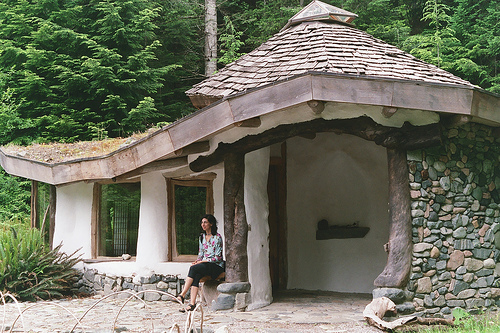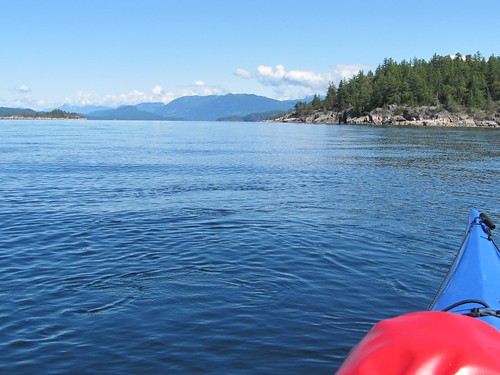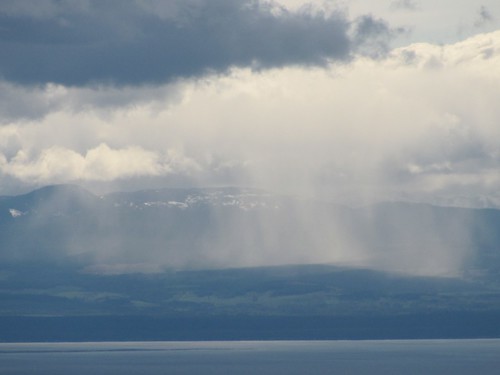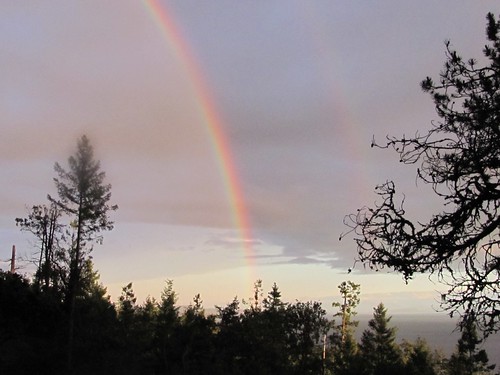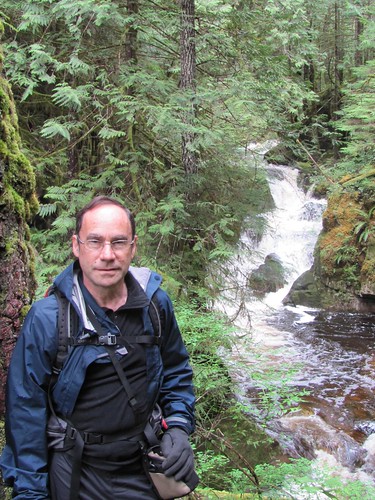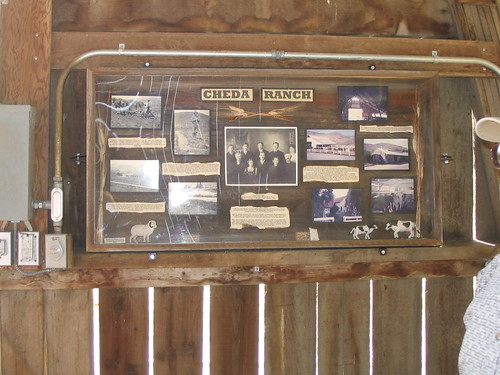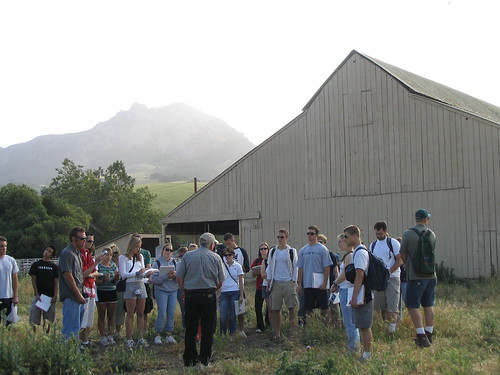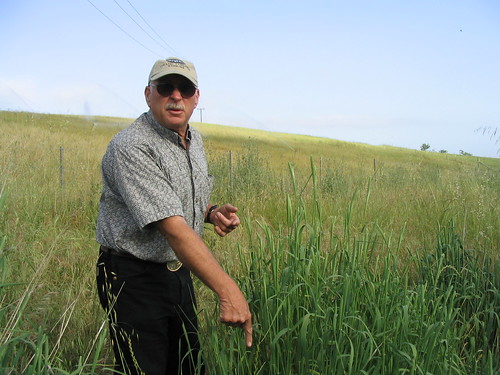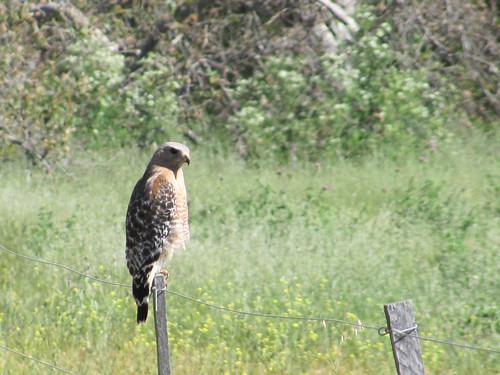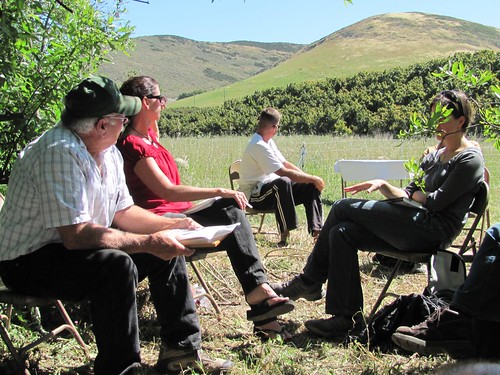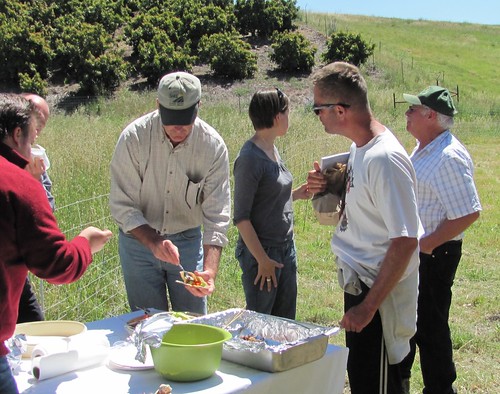Hollyhock Journal 7
July 5th, 2010
In her welcome talk, Dana mentioned that group meditation is available every day from 6:00 to 7:00 A.M in the Sanctuary for all Hollyhock visitors. This morning for the first time I feel ready to attend, but I arrive late. From a distance I see a candle burning on the porch. Inside under the dome sit Brenda, a fellow workshop participant, and the leader, a trim gray-haired woman in black workout garb. During our workshop sessions I’ve felt shy of looking at other people meditating. Now, as I settle on a cushion, the sight of her body’s perfect alertness and repose clicks me into emulation.
I’m aroused from stillness by two tolls of a small bell. Brenda and I follow suit when the leader stands up. With eyes open but blank, she moves slowly around the circle of cushions and speaks in a hypnotic monotone: “In walking meditation, we take a deep breath and lift the left foot from the heel first and place the toe in front of the right foot. We exhale while placing weight on it. We inhale while lifting the right foot and placing it in front of the left and exhale while placing weight on the it. We make our breathing and walking into a smooth continuous motion.” After a few awkward missteps I’m able to relax into the rhythm, observing my body’s method of locomotion, reminded of learning the flow in paddling a kayak.
After several circuits, she rings the bell once, signaling the end of the hour. At first, I find it difficult to talk but not to bow. I greet Brenda, apologize for being late and thank the leader for a powerful experience. Her face changes, features animate, eyes sparkle. I introduce myself and I tell her that Zen practice is new to me after several decades of doing TM, but that my wife is a member of S.F. Zen Center and goes to its Tassajara California monastery for annual retreats. Her name is Martha, she says. She was once cook at Tassajara, is a shareholder in Hollyhock, lives on her adjacent property, sells real estate on the island. She likes to conduct these sittings to balance the pace and stress of her daily life.
Back in Kiakum, our workshop resumes. The theme is emotion. Kate defines it as turbulence, the opposite of stillness, impermanence. In meditation, she says, we cultivate the ability to become intimate with intense emotions, experience them and let them pass. We become mindful of the modulations of the mind and how they are grounded in modulations of the body. We find release from their sway, a spacious place to work with them.
Ruth says that such mindfulness also allows us to write about emotions, find words to create characters with life and intensity. I don’t know about characters. For now, I’m only interested in finding the words to articulate and understand my own experience. That’s been a sanity saver for me since I started journaling in the ˜60’s and a way of validating my travels in retirement.
Kate says traditional Buddhism classifies the emotions as Five Hindrances to meditation, all of which cause suffering. First is Desire, a craving for the pleasure of the senses, or for that which is not in our possession; second is Aversion or ill-will, feelings of malice directed toward others, Third is Sloth and Torpor, resulting in procrastination, laziness, and half-hearted action, Fourth is Restlessness or agitation, which manifests as impatience and lack of concentration. Fifth is Doubt or loss of trust in one’s endeavor. Each has its traditional antidote. For Desire, it’s contemplating the necessity of impermanence. For Aversion, it’s kindness and forgiveness. For Sloth, it’s sufficient rest and curiosity. For Restlessness, it’s strengthening the powers of concentration and relaxation. For Doubt, it’s riding out the mood, finding external sources of inspiration and regularity of habits.
These formulations of the Five Hindrances and their cures help release me from some of the agitation I’ve felt on this trip: anxiety and exultation about the sea voyage, nostalgia in returning to Lund, excitement from exposure to new ideas, hero worship of a teacher, the succession of challenge, frustration, triumph and disappointment attendant upon writing.
I’m intrigued with the two-part definition of Desire, the emotion by which I’m most driven and threatened, but not satisfied by it or the brief description of the cure. Despite its power to humiliate and harm, I believe the dangerous energy of desire can, with luck, be funneled into positive expressions: conjugal love, creative inspiration, self-sacrifice.
Ruth assigns the first exercise as writing about and from an emotion we’ve felt. We’re to depict its manifestation in the body, without naming it, to show, not tell. Her prompts: “A time when I was wrong or bad, someone you were afraid of, a birth, a lie you told or believed.” I select the first, about guilt, stemming from lust and betrayal.
1962, age 20. I was heading from Stuttgart, my ancestral home town, to Paris on an old Lambretta I’d bought second-hand in London at the beginning of the summer. I’d said goodbye to Darleeen a couple of weeks before because the revulsion I experienced in hearing her talk started outweighing the attraction of her beautiful body. Now I wished I hadn’t. I was rutting and lonely. On the big roadmap I noticed that one possible route lay through Besancon, where Leah, my former girlfriend, was living as an exchange student for a year. During most of our sophomore year, we’d been soulmates and intellectual companions. Fellow children of Holocaust survivors, we read Hannah Arendt’s The Origins of Totalitarianism and cried together at the movie Hiroshima Mon Amour. We’d exchanged virginities on New Years Eve while my mother and father were out of town and we’d weathered a horrifying pregnancy scare, but I felt entrapped by her baleful gaze and sombre temperament, and extricated myself from the relationship with no explanation. I knew she still loved me.
Next we’re to rewrite it in third person present tense.
He’s riding from Stuttgart to Paris on an old motorscooter after saying goodbye to the girl he’d met at the language school in Grenoble and convinced to run away with him to the Riviera. She was 16, achingly beautiful, agonizingly dumb. After a gorgeous week and a half of wandering in Provence and Savoie, he’d left her at the train station in Geneva to return to her mother in Rome. They’d had nothing to talk about. Now, after three weeks by himself, he’s desperate with loneliness and desire. On the map, he notices that Besancon, the University town where his former girlfriend is an exchange student, lies in his path.
Finally we’re to tell the same incident from the other person’s point of view, using “you,” and introducing something made up. Not what I signed up for. I’ve written many memoirs in first person and one in third, but this is a frightening leap.
You stole my heart at Camp Moonbeam, Nature Steve, the summer after freshman year. All the girls were after you then and you were after them, but in the Fall, I’m the one that stuck. We talked of books and films and our heritage of the Holocaust. We went to see “Hiroshima Mon Amour,” and cried together afterwards. We wrote letters every day, and at Christmas break, when I came back to New York, we agreed to spend New Years Eve together at your house while your parents were on vacation.
Ruth says we’re now getting beyond cleaving to our own truths, we’re moving out into the world, from self-exploration to an act of generosity. She tells us the story of her own experience, one shared by many authors of fiction, when characters take on a life of their own and escape control of the author, who becomes a kind of medium. This is what happened a third of the way through her composition of All Over Creation. One day, the protagonist Yumi (“You-me”) started speaking in her own voice and forced her to rewrite everything that preceded.
In the next exercise, we’re again to take another person’s point of view and add some dialogue. The prompts: “an argument or a fight, a memorable kiss, the first person I hated, a separation or parting.”
The last alternative reminds me of parting from S…. , which I wrote about in my journal during the airplane trip from San Luis Obispo to Lund, trying to convey some of the pathos of the occasion and my affection for her.
The day before my departure for Canada, I went to say goodbye to Diana. In the rickety old house with 12-foot ceilings and no right angles, she lay on a high bed surrounded by white flowers, a white comforter and pillows and little sleeping dogs. After three years of struggle with painful, disfiguring disease and treatments, she’d reached the final stage. Her arms were literally skin and bones, the hair that she’d always died and thickened was sparse and wispy, but as she turned her head toward my greeting, her eyes were clear and radiant, her smoker’s skin smooth and moist as a baby’s, her smile at hearing my farewell, beatific.
I knew her as “The English Maid,” the rose-ringed logo on her van. My wife had hired her to clean her office and the rest of the house once a week when she moved her law practise home. Diana had long ago been a model and actress in London, and she spoke with a tony accent in a beautiful stage voice as she cleaned the toilets and carried out the trash. She was a serious breeder of Yorkshire Terriers and traded orderly service at the veterinary clinic next door for free rent. She repeatedly resisted her children’s urging to join them in L.A. or Japan, instead preferring a succession of mysterious young men as roommates.
I’d thought repeatedly of what I wanted to say as last words, the task an ultimate challenge for expression, but also a ritual courtesy, since such occasions have been frequent lately. I told Diana she’d had a powerful impact on me, that her combination of humility and elegance and of reserve and sympathy gave me inspiring examples of how to construct a coherent life braced with paradox.
She couldnt speak because of a recent tracheotomy, but she whispered something about loving our babies and held me with a gaze I finally had to avert. Eyes wet, I touched her cheek and kissed her hand and left the room. In the parlor I marvelled about her looks and energy with her daughter-in-law, who told me that Diana was producing the perfect Hollywood departure scene, sharing her joy and beauty with many visitors who filled the house with love. When she asked her mother-in-law this morning how she was doing, Diana had said, “I’m in heaven.”
For the exercise I try to imagine the same encounter from her point of view.
“Steven Marx is here to see you,” she says.
I might not have remembered who that is, but Jan was here yesterday to bring Tai to say goodbye. How I loved that little bitch, who bore me eighteen puppies over just three years. I went all the way to Ireland to bring her back to breed with Timmie and hated to let her go the first time, when she couldnt get along with the whole gang here, and then I got to have her back in exchange for Star, one of the first litter she had at Marx’s house who sweet little Ian couldn’t let go. And when Star died a year later from chewing a copper wire behind Jan’s desk, down where the cobwebs always gather, they wouldnt have another dog¦until I called and told them I had to give up all my babies and they took her back again.
This writing produces mixed feelings. I’m relieved that I’ve found a way to complete the assignment, pleased that, for ten minutes at least, I was able to adopt a new persona and gain a different perspective that contrasts my solemn and self-centered tribute to her engagement with the dogs and details of housekeeping. But I also feel guilty. This appropriation of the woman’s deathbed consciousness isn’t answerable to her or her memory, to those who knew her, or to the actual truth of the situation, which has been reduced to mere stimulus and raw material for my imaginative processing. Ruth tells us that on the eve of her first novel’s going to press, she decided to adopt the name pseudonym Ozeki to hide her family name in consideration of her father, who might be embarrassed if his friends and relatives found resemblances between incidents in the book and what they knew about his life. I take a further liberty to rename my character.
In the lodge before dinner I plan to test the camera again to see if after another day’s drying on the mantle has allowed it to function. It’s gone missing and a thorough search by the staff cant locate it. Could even this place harbor a thief?

